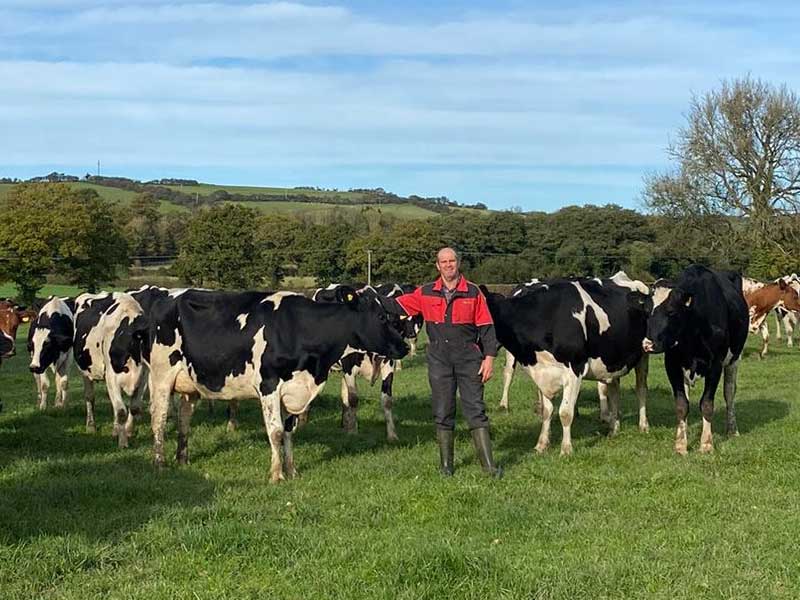
Carmarthen

191 acres
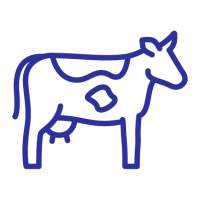
70
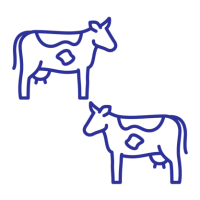
388 days calving index
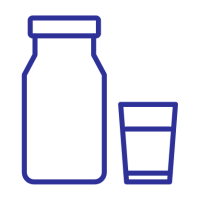
8,200l/cow
About Anthony, his farm and his herd
Based near Carmarthen, Anthony’s herd of 70 dairy cows has a calving index of 388 days. On average Anthony gets 8,200l/cow with an average butterfat of 4.4% and protein 3.33%. The herd is predominantly Holstein Friesian, with four Ayreshires – a legacy of Anthony’s grandfather.
The farm’s 191 acres is split between two holdings, both are on heavy land so the herd is usually indoors from early October until early-April. Anthony strip grazes, moving the fence morning and night. If the weather is suitable, Anthony pre-mows fields ahead of the third grazing. He says it helps to encourage the cattle eat the grass, and ensure fresh and even following growth. In 2022, despite the drought, had good quality grass all through the summer. And good silage means that he is hoping to be able to keep the cows on 14% protein cake throughout the winter.
With two holdings, Anthony’s got two slurry pits. One is 200,000 gallons and the other 450,000 gallons.
Treatment and application

38kg

145ac

12 weeks
38kg of the slurry inoculant was applied to the tank in early January 2022. And while there was already a significant proportion of slurry already in the system which would have volatilised, analysis showed notable retention of nitrogen.
The slurry additive had just 12 weeks before the tank was emptied.
The treated slurry was applied to 145 acres of pasture.
Results
- 21.8% more forage with SlurryForSoil™
In 2022, it took just 119 acres to fill the clamp, in comparison with took 145 acres in 2021. Anthony started feeding cattle silage earlier than usual and baled the remaining excess. It’s estimated that the acreage produced an additional 21.8% of forage.
- 14.2% less nitrogen needed
Due to the increase in the amount nutrients retained with the slurry, Anthony was able to reduce the amount of synthetic fertiliser used. Over the whole season:
2021: 187.4N – 6.2P – 44.6K – 19.4S – 18.5Na
2022: 160.8N- 7.0P- 7.0K- 0.0S- 0.0Na
A reduction of 14.2% in nitrogen and of 84.2% in potassium (notably no sulphur was added this year).
Conclusion

Up 21.8%
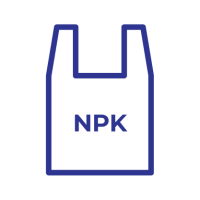
Down 35.8%

Reduced by 30%
ROI £131.16/acre
Using SlurryForSoil™ reduced Anthony’s fertiliser bill by 35.8% while increasing forage yield by 21.8%. This nearly halved his costs of production in comparison with the previous year.
The reduced synthetic fertiliser usage also reduced his carbon emissions by 30%/unit of forage. Across the whole farm, this equates to nearly 16t of carbon, and doesn’t include the fuel saved as a result of the slurry needing less stirring in stores.
Anthony’s thoughts:
“While there’s lots of data and stats behind the product, there’s one that matters to me – I needed 14% less nitrogen this year,” said Anthony.
“We also found that it took less than half the time to stir the slurry before spreading and was a nice creamy consistency. We had negligible blockages with both the trailing shoe and spreader bar, and the slurry was incorporated into the soil faster.”
“The resulting swaths were noticeably bigger too. We made first cut silage from 119 acres this year and the clamp was fuller than when we did the same with 145 acres last year,” he said.

